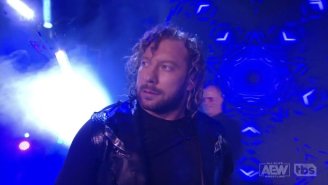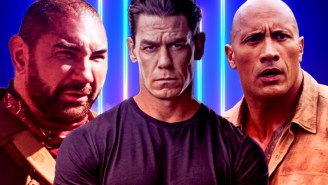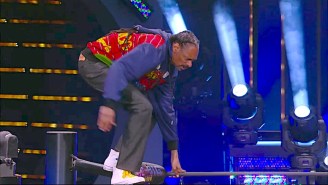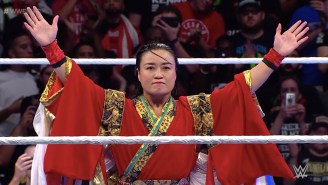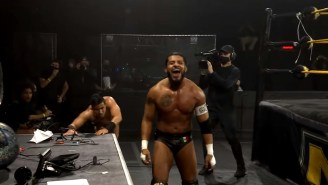There’s an unwritten rule in pro wrestling that it’s okay to recycle characters and storylines every seven years because that’s generally how long it takes for the fanbase to turnover and wipe the slate clean. That’s maybe a bit extreme. Most of the people reading this have probably been wrestling fans for longer than seven years, but there’s no denying that wrestling does a terrible job of preserving its history. It doesn’t help that the entire business is lorded over by a company that likes to pretend wrestling was invented in 1983 and frequently demands that its viewers forget what they saw just last week.
Due to this never look back attitude, fans tend to treat every new trend and hot topic like a never-seen-before calamity. Every new controversy is a shocking affront to the proud wrestling traditions of yesteryear, or alternatively, a deserved thumb to the eye of the terrible wrestling traditions of yesteryear. Twitter, which was designed exclusively for people to scream 140-character slogans at each other, hasn’t helped matters.
The reality is, pro wrestling as we know it has existed for more than 100-years, and almost everything you’ve battled over online was being argued about decades before you were born. Nothing is new under the bright lights. Here’s a few things that have been a part of pro wrestling far longer than you thought…
Hardcore Wrestling Started In The ’30s, And Guys Were Bleeding Buckets In The ’50s
To hear some folks talk, wrestling was purely a mannerly sport of wristlocks and manly tests of strength before ECW came along in the ’90s and sullied the business forever. Turns out, Paul Heyman’s “revolutionary” promotion was actually based on a style of wrestling that had been around for a solid 50 years by then.
The creation of hardcore wrestling is generally credited to “Wild” Bull Curry, the most hilariously cartoony villain to ever step into a ring. Just look at this guy…
This is an actual human being. No, really.
As early as the 1930s, Bull Curry was swinging chairs and brass knucks and brawling outside the ring. By the time the 1950s came around, things were in full swing as guys like Freddie Blassie, Dory Funk, Sr., Killer Karl Kox and a still very active Bull Curry were having hard-fought bloody brawls every night. From there, guys like the original Sheik and Abdullah the Butcher hit the scene, and things truly got gory. ECW wasn’t nearly as cutting edge as it sold itself as. If anything, it was downright retro.
Everybody Knew Wrestling Was Fake As Early As The 1910s
The opening of the wrestling business and destruction of “kayfabe” has been one of the most relentlessly chewed over subjects of the past 25 years. Today, the generally accepted narrative is that pro wrestling was once a magical, innocent thing, and children believed in Hulk Hogan like Santa Claus, but then the ’90s came around, and the Vince McMahon steroid trials happened, Brian Pillman called somebody “booker man,” Vince Russo was born of some dank pit of iniquity and wrestling was never the same.
The reality is, everybody knew this shit was bogus pretty much right from the start. Pro wrestling experienced its first real boom in and around 1910 on the back of World Champion Frank Gotch’s feud with European champ George Hackenschmidt. Five years later, pro wrestling would suffer its first major crash. According to the the legendary Lou Thesz, this was because everyone already had the game figured out. They knew pro wrestling was largely predetermined and not a “serious” sport.
While the guys at the time didn’t outright admit to any fakery, the business indirectly acknowledged it had been outed. After the 1910s, pro wrestling stopped trying to present itself as a legitimate sport, and instead started pushing wrestling as exciting entertainment. Sound familiar? The in-ring action was punched up, new stipulations like the exotic tag team match were introduced and guys started playing up their personalities, leading to the rise of guys like Gorgeous George.
The only thing real about Gorgeous George was how hot he made your grandma.
The way things are now was the way things were for the vast majority of pro wrestling history. Kids thought it was real, but adults knew the score. Once your brain solidified around the age of 12, you noticed that none of the punches were actually landing, so you stopped believing wrestling was real and either moved on or learned to enjoy the shows as performance art. So, “It’s still real to me” guy would have been a dork in any era.
Screwjobs That Make Montreal Look Like Nothing Were Rampant In The ’20s And ’30s
The Montreal Screwjob was, like, the most shocking event in wrestling history, right? It tore open the business and kicked off the Attitude Era! It made and destroyed careers! What could compare? Well, during the ’20s and ’30s, pro wrestling saw a series of screwjobs that made Montreal look like kids’ stuff.
During the ’20s and ’30s, pro wrestling was transitioning into scripted entertainment, but there were still plenty of legit grapplers who hadn’t been given the “it’s now fake” memo hanging around. That caused a lot of problems.
Probably the most infamous screwjob of the era was the Wayne Munn/Stanislaus Zbyszko title change of 1925. Wayne Munn had no real background in wrestling, but he was a former football player, closing in on 7-feet tall and a crowd favorite. The dominant champ of the era, Ed “Strangler” Lewis, thought there would be money in making Munn the champion briefly, then taking the title back from him. Unfortunately for Lewis, once Munn had the championship, rival promoter Joe Stecher saw his chance to strike. Stanislaus Zbyszko, the ultimate old-timey strongman and carnival grappler, was supposed to lose a title match to Munn, but Stecher convinced Zbyszko to go against the booking. Zbyszko mauled Munn, legitimately destroying the giant and pinning him multiple times until the ref was forced to declare him the winner and new champ. A month later, Zbyszko dropped the belt to Stecher, completing the devilish plot.
You shoulda Zbyszko-ed him, Bret.
The Zbyszko screwjob would have longstanding consequences. It would lead to a split in the world title, expose the business in a massive way, and dictate the kind of men who could become champion for many years (nobody would risk a champ without serious wrestling credentials for decades to come). And the things is, the Zbyszko incident was just one of half a dozen high profile screwjobs from the same era. Bring back the days when guys “shooting” meant somebody was getting their ass beat, I say.
Intergender Matches Have Been Around As Long As Women Have Been Wrestling
Okay, let’s get into this. Intergender wrestling is the new thing to get hot about on the internet. The spectrum of opinions range from “this is our one hope for gender equality in wrestling” to “ladies fighting men is an evil SJW plot.” Wherever you fall, intergender wrestling is totally this crazy new thing you need to get agitated about. Except, it isn’t. Intergender matches have been a staple of pro wrestling even since the very first lady grapplers laced up their boots.
The original queen of women’s professional wrestling, Mildred Burke, started her career wrestling men. During the 1930s, it’s said she wrestled at least 200 men in semi-shoot wrestling matches and only lost once. Going back even further, woman grapplers were a common sight during pro wrestling’s carnival side show infancy. Back in those days, wrestlers would typically take on challengers from the audience, which for female wrestlers usually meant fighting men. It wouldn’t have been socially unacceptable for a 19th century woman to challenge somebody to a fight, but there were plenty of dumb and/or drunk rubes willing to. Any woman wrestler not well-trained in putting dudes in their place certainly wouldn’t last long on the carnival circuit.
Since those early days, the acceptability and popularity of intergender wrestling has ebbed and flowed, often peaking during times when there wasn’t a lot of opportunity or outlets for women to wrestle same-sex matches. As long as pro wrestling has existed, there’s been badass women willing to take on anybody regardless of gender for the sake of competition, and there always will be, so let’s stop being so weird about the whole thing. If your great grandparents weren’t fussed about Mildred Burke trading holds with dudes, we don’t need to lose our minds about it in 2015.
Wrestlers Started Using Steroids In The 1960s
When you think about steroids in wrestling, you obviously think of the ’80s and ’90s, but your mind probably doesn’t jump to the ’60s. Everyone had Don Draper or wheatgrass-fed hippie bodies back then, right? Well, it turns out the ’60s weren’t as natural as your Baby Boomer parents would have you believe.
The Olympic weight lifting and wrestling teams were some of the first American athletes to start using anabolic steroids, getting on the juice in the early-’60s. A lot of pro football players would follow. There’s a lot of overlap between amateur wrestling, weight lifting, football and pro wrestling, and steroids began to seep into the wrestling world in the mid-’60s. Superstar Billy Graham has admitted that he started using steroids in the ’60s, and it’s widely believed that other wrestlers like the wall-like Dick the Bruiser were also using.
It was totally normal for white dudes to have Big E Langston bodies in the ’60s, right?
Granted, steroid use became much more prevalent in the ’80s, but Vince McMahon didn’t create the steroid craze. He just nudged an already well-established thing to the next crazy level.
The more wrestling changes, the more it stays the same. Perhaps now that we’ve placed some of these subjects in their proper context, we can discuss them in a broader, more rational way. Then again, I suppose not seeing the bigger picture is a cherished wrestling tradition in its own right.

